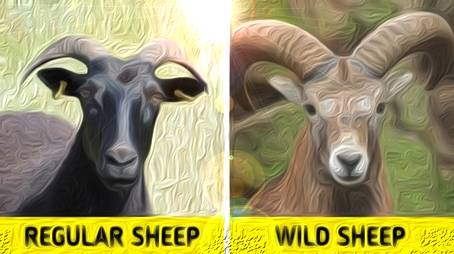About 10,000 years ago, the people of Mesopotamia began to domesticate animals for food, dairy products, and fur. Pet skins were used to make clothing, storage containers, and tents. Goats were probably the first domesticated species, soon followed by sheep. As a result, the same animals began to look different, and it is natural that many people find it difficult to distinguish between wild and domesticated species.
-
Conventional Cats vs. Wild Cats

A Missouri farmer recently captured a mysterious and unusual cat that had been seen on his property for several months. He has been identified as an African serval by the Turpentine Creek Wildlife Sanctuary and likely escaped from captivity and was left alone. However, rescuers believe that its survival would not have lasted much longer, as it was not adapted to the cold winter climate of the Midwest.
The serval weighs 29 pounds, about three times the weight of the average house cat, according to the shelter. He is estimated to be around five years old, about a quarter of his normal lifespan.
-
Common and feral dogs

It is widely believed among researchers that the gray wolf is the progenitor of the domestic dog. The time frame of this transformation is believed to have occurred between 32,000 and 14,000 years ago. However, there is a minority of scientists who argue that dogs may have evolved from an extinct wild ancestor, potentially similar to today’s marginalized dogs or dingoes. Regardless of its origin, the dog remains the first animal domesticated by humans.
The centuries-old affection for dogs has led to the creation of more than 400 breeds of domestic dogs. Research into the origins of dogs and their special connection to humans continues today.
-
Conventional vs. wild goats

Humans have selectively bred the bezoar, also known as the wild goat, as a second type of wild animal. At first glance, these agile and hardy ungulates may not seem like ideal candidates for domestication, but their ability to transform scarce plants into valuable resources like fur, meat, and milk has made the efforts of colonists in the Fertile Crescent worthwhile. The breeding of these animals began 11,000 years ago and gave rise to generations of solitary goat herders.
Domestic goats currently have more than 200 different breeds. From tiny miniatures kept as pets, to soft-coated cashmere goats used to make cloth, to large animals weighing around 300 pounds.
-
Conventional sheep vs wild sheep

About 10,000 years ago, several subspecies of this wild sheep (mouflon) were brought from the mountains. Their offspring eventually became the ancestors of the first uggs and sheepskin coats. Only a few thousand years later, wool-producing varieties appeared. Previously, they were killed for their skin and meat, rather than being raised for wool production.
Domestic sheep include more than 200 breeds, from breeds that produce excessive amounts of wool and require regular shearing to prevent overheating, to tropical varieties with soft, goat-like fur. Despite sheep’s reputation for being docile and easy to handle, some breeds display an exceptional level of intelligence, including the ability to recognize their own names.
-
Common and wild pigs

About 9,000 years ago, someone bravely captured a group of wild boars, probably in what is now Turkey. Chinese and European wild boars were probably independently domesticated. Regardless of their origin, their descendants were forced to live off human waste. In ancient cities, pigs commonly roamed the streets, eating garbage and serving as an easily accessible source of meat.
The once ferocious warthog has been domesticated into some 70 breeds of domesticated pig, ranging from rosy pigs to large, hairy breeds adapted to specific conditions. Despite their widespread disrepute, pigs are highly intelligent animals. Recent medical advances suggest they could even be used to grow new hearts for transplants.
-
Ordinary vs. Wild Cows

The lineage of cattle goes back to the extinct aurochs. Like many other species, cattle have most likely been domesticated multiple times. The first case of domestication occurred about 10,500 years ago in Iran. The zebu is believed to have descended from the Indian subspecies of the aurochs some 6,000 years later.
African cattle are descended from an earlier line and then crossed with a type of Indica known for its distinctive hump, which provides better adaptation to warmer climates. There are over 800 recognized breeds of cattle, although only a small fraction are recognized by breeding organizations. The number of cattle heads in the world is estimated at 1,500 million heads.


